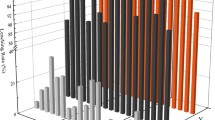Abstract
In this paper, an efficient recovery of rare earth elements from waste fluorescent phosphors has been reported and the novel process of alkali fusion and acid leaching has been proposed. The experimental results have shown that the key for efficient recycling is the complete dissolution of waste fluorescent phosphors. The Na2O2-to-waste mass ratio, calcination temperature and reactive time play considerable roles in rare earth elements extraction during the alkali fusion process. The optimal conditions in terms of temperature, time and Na2O2-to-waste mass ratio are 650 °C, 15 min and 2:1, respectively, under which more than 99.5 % rare earth elements are extracted. The possible reaction mechanism of alkali fusion has been proposed.








Similar content being viewed by others
References
Liu YJ (2007) Present state and main task of development of rare earth industry in China. J Chin Rare Earth Soc 25(3):257–263
Wang LT, Meng QG, Hu SW (2008) Research progress on rare earth fluorescent materials. J Weifang Univ 8(6):111–113
Li HM (2010) Recovery of rare earths from phosphor sludge by acid leaching. Chin J Rare Metals 34(6):898–904
Cheng JZ, Che LP (2010) Current mining situation and potential development of rare earth in China. Chin Rare Earths 31(2):65–70
Song JH, Li N (2012) Dilemmas and countermeasures of implementing a strategic reserve of rare earths in China. Nonferrous Metals Sci Eng 3(6):95–99
Zhang QJ, Wu YF, Cheng HQ, Yin XF, Wang W (2013) Research status and developing tendency of the recycling technologies of rare earth phosphors. Environ Pollut Control 8:79–83
Li RQ, Wu YF, Zhang QJ, Wang W (2012) Extraction of rare earths from trichromatic fluorescent powder waste by high-temperature alkali fusion method. Metall Anal 32:795–799
Resende LV, Morais CA (2010) Study of the recovery of rare earth elements from computer monitor scraps—leaching experiments. Miner Eng 23(3):277–280
Wu YF, Li RQ, Zhang QJ, Wang W (2013) Extraction of rare earth elements from waste trichromatic fluorescent phosphors. Adv Mater Res 788:279–282
Hirajima T, Sasaki K, Bissombolo A, Hiraib H, Hamadac M, Tsunekawad M (2005) Feasibility of an efficient recovery of rare earth-activated phosphors from waste fluorescent lamps through dense-medium centrifugation. Sep Purif Technol 44(3):197–204
Wu YF, Zhang QJ, Yin XF, Cheng HQ (2013) Template-free synthesis of mesoporous anatase yttrium-doped TiO2 nanosheet-array films from waste tricolor fluorescent powder with high photocatalytic activity. RSC Adv 3:9670–9676
Otsuki A, Mei GJ, Jiang YR, Matsuda M, Shibayama A, Sadaki J, Fujita T (2006) Solid-solid separation of fluorescent powders by liquid–liquid extraction using aqueous and organic phases. Resour Process 03(3):121–133
Takahashi T, Takano A, Saitoh T, Nagano N, Hirai S, Shimakage K (2002) Synthesis of red phosphor (Y2O3:Eu3+) from waste phosphors sludge by coprecipitation process. Shigen Sozai 118(5/6):413–418
Porob DG, Srivastava AM, Nammalwar PK, Ramachandran GC, Comanzo HA (2012) Rare earth recovery from fluorescent material and associated method. US Patent, US 8,137,645 B2
Rabah MA (2008) Recyclables recovery of europium and yttrium metals and some salts from spent fluorescent lamps. Waste Manag 28:318–325
Hirajima T, Sasaki K, Bissombolo A, Hirai H, Hamada M, Tsunekawa M (2005) Feasibility of an efficient recovery of rare earth-activated phosphors from waste fluorescent lamps through dense-medium centrifugation. Sep Purif Technol 44:197–204
Wu YF, Wang BL, Zhang QJ, Li RQ, Yu JM (2014) A novel process for high efficiency recovery of rare earth metals from waste phosphors using a sodium peroxide system. RSC Adv 4:7927–7932
Barker MG, Frankham SA, Gadd PG (1981) Polymorphism in some sodium lanthanide-metal ternary oxides of the type NaLnO2. J Inorg Nucl Chem 43(11):2815–2819
Acknowledgments
This work was financially supported by the National High Technology Research and Development Program of China (863 Program) (2012AA063207), State Key Laboratory of Solid Waste Reuse for Building Materials, National Natural Scientific Foundation of China (No. 21306004), the 12th foundation of science and technology for the Beijing University of Technology (ykj-2013-9748).
Author information
Authors and Affiliations
Corresponding authors
Rights and permissions
About this article
Cite this article
Wu, Y., Wang, B., Zhang, Q. et al. Recovery of rare earth elements from waste fluorescent phosphors: Na2O2 molten salt decomposition. J Mater Cycles Waste Manag 16, 635–641 (2014). https://doi.org/10.1007/s10163-014-0295-1
Received:
Accepted:
Published:
Issue Date:
DOI: https://doi.org/10.1007/s10163-014-0295-1




